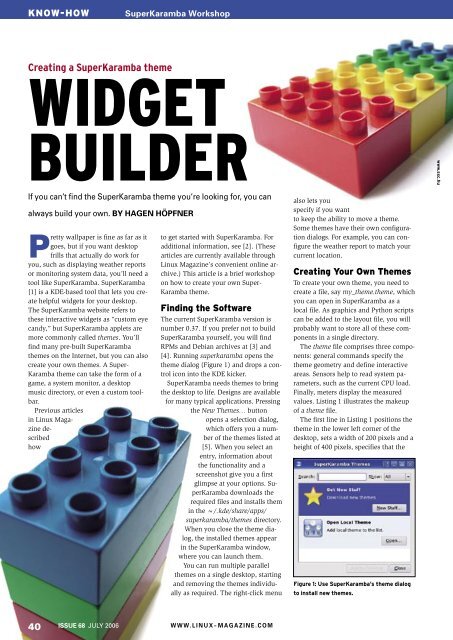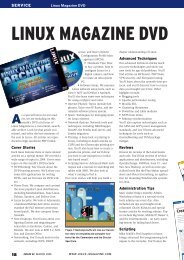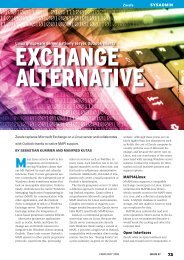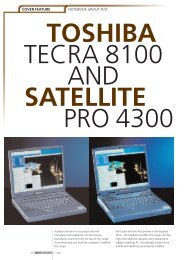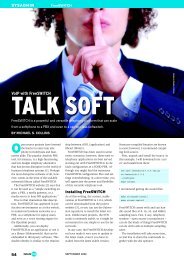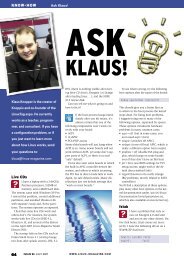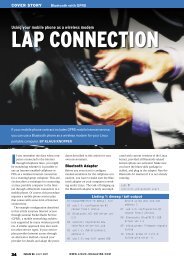Creating a SuperKaramba theme - Linux Magazine
Creating a SuperKaramba theme - Linux Magazine
Creating a SuperKaramba theme - Linux Magazine
Create successful ePaper yourself
Turn your PDF publications into a flip-book with our unique Google optimized e-Paper software.
KNOW-HOW<br />
Pretty wallpaper is fine as far as it<br />
goes, but if you want desktop<br />
frills that actually do work for<br />
you, such as displaying weather reports<br />
or monitoring system data, you’ll need a<br />
tool like <strong>SuperKaramba</strong>. <strong>SuperKaramba</strong><br />
[1] is a KDE-based tool that lets you create<br />
helpful widgets for your desktop.<br />
The <strong>SuperKaramba</strong> website refers to<br />
these interactive widgets as “custom eye<br />
candy,” but <strong>SuperKaramba</strong> applets are<br />
more commonly called <strong>theme</strong>s. You’ll<br />
find many pre-built <strong>SuperKaramba</strong><br />
<strong>theme</strong>s on the Internet, but you can also<br />
create your own <strong>theme</strong>s. A Super-<br />
Karamba <strong>theme</strong> can take the form of a<br />
game, a system monitor, a desktop<br />
music directory, or even a custom toolbar.<br />
Previous articles<br />
in <strong>Linux</strong> <strong>Magazine</strong>described<br />
how<br />
<strong>SuperKaramba</strong> Workshop<br />
<strong>Creating</strong> a <strong>SuperKaramba</strong> <strong>theme</strong><br />
WIDGET<br />
BUILDER<br />
If you can’t find the <strong>SuperKaramba</strong> <strong>theme</strong> you’re looking for, you can<br />
always build your own. BY HAGEN HÖPFNER<br />
to get started with <strong>SuperKaramba</strong>. For<br />
additional information, see [2]. (These<br />
articles are currently available through<br />
<strong>Linux</strong> <strong>Magazine</strong>’s convenient online archive.)<br />
This article is a brief workshop<br />
on how to create your own Super-<br />
Karamba <strong>theme</strong>.<br />
Finding the Software<br />
The current <strong>SuperKaramba</strong> version is<br />
number 0.37. If you prefer not to build<br />
<strong>SuperKaramba</strong> yourself, you will find<br />
RPMs and Debian archives at [3] and<br />
[4]. Running superkaramba opens the<br />
<strong>theme</strong> dialog (Figure 1) and drops a control<br />
icon into the KDE kicker.<br />
<strong>SuperKaramba</strong> needs <strong>theme</strong>s to bring<br />
the desktop to life. Designs are available<br />
for many typical applications. Pressing<br />
the New Themes… button<br />
opens a selection dialog,<br />
which offers you a number<br />
of the <strong>theme</strong>s listed at<br />
[5]. When you select an<br />
entry, information about<br />
the functionality and a<br />
screenshot give you a first<br />
glimpse at your options. <strong>SuperKaramba</strong><br />
downloads the<br />
required files and installs them<br />
in the ~/.kde/share/apps/<br />
superkaramba/<strong>theme</strong>s directory.<br />
When you close the <strong>theme</strong> dialog,<br />
the installed <strong>theme</strong>s appear<br />
in the <strong>SuperKaramba</strong> window,<br />
where you can launch them.<br />
You can run multiple parallel<br />
<strong>theme</strong>s on a single desktop, starting<br />
and removing the <strong>theme</strong>s individually<br />
as required. The right-click menu<br />
40 ISSUE 68 JULY 2006 W W W. L I N U X- M A G A Z I N E . C O M<br />
also lets you<br />
specify if you want<br />
to keep the ability to move a <strong>theme</strong>.<br />
Some <strong>theme</strong>s have their own configuration<br />
dialogs. For example, you can configure<br />
the weather report to match your<br />
current location.<br />
<strong>Creating</strong> Your Own Themes<br />
To create your own <strong>theme</strong>, you need to<br />
create a file, say my_<strong>theme</strong>.<strong>theme</strong>, which<br />
you can open in <strong>SuperKaramba</strong> as a<br />
local file. As graphics and Python scripts<br />
can be added to the layout file, you will<br />
probably want to store all of these components<br />
in a single directory.<br />
The <strong>theme</strong> file comprises three components:<br />
general commands specify the<br />
<strong>theme</strong> geometry and define interactive<br />
areas. Sensors help to read system parameters,<br />
such as the current CPU load.<br />
Finally, meters display the measured<br />
values. Listing 1 illustrates the makeup<br />
of a <strong>theme</strong> file.<br />
The first line in Listing 1 positions the<br />
<strong>theme</strong> in the lower left corner of the<br />
desktop, sets a width of 200 pixels and a<br />
height of 400 pixels, specifies that the<br />
Figure 1: Use <strong>SuperKaramba</strong>’s <strong>theme</strong> dialog<br />
to install new <strong>theme</strong>s.<br />
www.sxc.hu
Figure 2: Before you start building your own <strong>SuperKaramba</strong><br />
<strong>theme</strong>, you might like to check out some of the <strong>theme</strong>s available<br />
on the Internet.<br />
<strong>theme</strong> can be moved, and sets a refresh<br />
time of 1000 milliseconds. You could set<br />
the position for the <strong>theme</strong> by specifying<br />
x and y offsets from the top left corner of<br />
the desktop.<br />
The BOTTOM=true parameter overrides<br />
the horizontal position. In a similar<br />
fashion, the RIGHT=true option positions<br />
the <strong>theme</strong> on the right margin.<br />
ONTOP=true prevents other windows<br />
hiding the <strong>theme</strong>. TOPBAR=true and<br />
BOTTOMBAR=true dock the <strong>theme</strong> at<br />
the top or bottom of the screen, just like<br />
the KDE kicker, without allowing maximized<br />
windows to hide it.<br />
The second line in Listing 1 sets the<br />
default font type, size, and color for all<br />
text elements associated with the <strong>theme</strong>.<br />
The color code defines a combination of<br />
values for red, green, and blue with a<br />
maximum value of 255. The example in<br />
Listing 1 uses 255, 255, 255, which is the<br />
<strong>SuperKaramba</strong> Workshop<br />
code that represents<br />
white.<br />
Sensors and<br />
Meters<br />
Lines 5 and 6 in Listing<br />
1 create two text<br />
meters that derive<br />
their content from the<br />
time sensor (sensor<br />
=time). Line 5 outputs<br />
the time and<br />
overrides the default<br />
font size, which was<br />
defined previously. It<br />
is a good idea to use<br />
tags to group similar elements;<br />
this improves readability<br />
and lets you specify a position<br />
for the group.<br />
The first group in our sample<br />
<strong>theme</strong> is located at x=10<br />
and y=10; besides the time<br />
and date meter, it contains a<br />
definition for the interactive<br />
area. Line 7 tells Super-<br />
Karamba to call the KDE time<br />
setting command when the<br />
120 by 34 pixel area is doubleclicked.<br />
The preview=true parameter<br />
draws a frame round<br />
the <strong>theme</strong> to indicate that it is<br />
still undergoing testing.<br />
The format parameter defines<br />
the output content and<br />
format of a field depending on<br />
the sensor you query. The "hh:<br />
mm:ss" format parameter tells<br />
the time sensor to give you hour:minute:<br />
second formatted time output, whereas<br />
format="ddd dd.MM.yyyy" gives you<br />
the weekday, the day of the month, the<br />
month and the year. Besides the time<br />
sensor, <strong>SuperKaramba</strong> has the following<br />
sensors:<br />
• cpu: System load<br />
• disk: Disk usage for mounted file<br />
systems<br />
• memory: Free and used main memory<br />
• network: Incoming and outgoing network<br />
traffic<br />
• noatun: Information from a running<br />
noatun process<br />
• program: Standard output from any<br />
program<br />
• sensor: Processes the<br />
LM sensor [10] output<br />
• textfile: Continually<br />
reads a text file<br />
• uptime: System uptime<br />
• xmms: Information<br />
from an XMMS process<br />
The second group in<br />
Listing 1 illustrates the<br />
use of some of these<br />
sensors in combination<br />
with various output devices.<br />
Line 12 reads you<br />
the free memory in<br />
Megabytes without buffer<br />
and cache memory.<br />
Line 14 uses the bar.png<br />
image to create a bar diagram<br />
that indicates the<br />
current CPU load.<br />
Figure 3: Thanks to the<br />
Python interface, pro-<br />
gramming <strong>theme</strong>s with<br />
extended functionality is<br />
quick and easy.<br />
Table 1: <strong>SuperKaramba</strong> Callback Functions<br />
KNOW-HOW<br />
Function Trigger Parameters passed<br />
initWidget(widget) Create the <strong>SuperKaramba</strong> widget<br />
widgetUpdated(widget) Update the <strong>theme</strong> Update interval from the .<strong>theme</strong> file<br />
widgetClicked(widget, x, y, button) Mouse click on <strong>theme</strong> x and y: coordinates for click relative to <strong>theme</strong>; button:<br />
mouse button used<br />
widgetMouseMoved(widget, x, y, button) Mouse movement within the <strong>theme</strong> x and y: coordinates for click<br />
relative to <strong>theme</strong>; button: mouse button used<br />
menuItemClicked(widget, menu, id) Click on menu item menu: Menu handle; id: Menu item handle<br />
menuOptionChanged(widget, key, value) Configuration menu item called in <strong>theme</strong> key: Menu item handle; value: new value for menu item<br />
(true or false)<br />
meterClicked(widget, meter, button) Click on meter device meter: Meter device handle; button: mouse button used<br />
commandOutput(widget, pid, output) Programm called via executeInteractive(), if output goes to stdout pid: Process<br />
ID for program; output: Output text<br />
itemDropped(widget, dropText) Objects dropped on <strong>theme</strong> in drag & drop operatons dropText: Text for object (e.g. URL).<br />
startupAdded(widget, startup) KDE starts an application After launching completes, the startupRemoved() and<br />
taskAdded() signals follow<br />
startupRemoved(widget, startup) See startupAdded().<br />
taskAdded(widget, task) See startupAdded().<br />
taskRemoved(widget, task) End of application program<br />
activeTaskChanged(widget, task) Moves an application to the foreground<br />
W W W. L I N U X- M A G A Z I N E . C O M<br />
ISSUE 68 JULY 2006<br />
41
KNOW-HOW<br />
01 KARAMBA x=0 BOTTOM=true w=200 h=400 LOCKED=false INTERVAL=1000<br />
02 DEFAULT font="Sans" fontsize=10 shadow=2 color=255,255,255<br />
03<br />
04 x=10 y=10<br />
05 TEXT x=12 y=0 sensor=time fontsize=12 format="hh:mm:ss"<br />
06 TEXT x=12 y=15 sensor=time format="ddd dd.MM.yyyy"<br />
07 CLICKAREA x=0 y=0 w=120 h=34 onclick="kdesu kcmshell clock"<br />
08 <br />
09<br />
10 x=10 y=50<br />
11 TEXT x=12 y=0 value="MEM"<br />
12 TEXT x=45 y=0 sensor=memory format="%fmb MB"<br />
13 TEXT x=12 y=15 value="CPU"<br />
14 BAR x=45 y=15 sensor=cpu path="bar.png"<br />
15 TEXT x=12 y=30 value="IN"<br />
16 GRAPH x=45 y=30 h=12 w=70 color=255,255,255 points=100<br />
sensor=network device="eth0" format="%in"<br />
17 IMAGE x=0 y=50 path="background.png"<br />
18 <br />
A graph is used to evaluate incoming<br />
network traffic in Line 16. The graph is<br />
12 x 70 pixels and white. The last line in<br />
this group uses the IMAGE output device<br />
to display an image. The PATH optionally<br />
accepts a URL, which allows you to<br />
embed an image from the Internet. Documentation<br />
on the formatting options for<br />
the various output devices is at [9].<br />
<strong>SuperKaramba</strong> and Python<br />
The Python interface [11] helps make a<br />
<strong>theme</strong> more flexible. Callback functions<br />
01 import karamba # Imports the Karamba API<br />
02 import string # String manipulation functions<br />
03 image=0<br />
04<br />
05 def initWidget(widget):<br />
06 global image<br />
07 karamba.acceptDrops(widget)<br />
add the ability to react to events triggered<br />
on the KDE desktop (Table 1). To<br />
allow a <strong>theme</strong> to access a Python file,<br />
the file must reside in the same directory<br />
as the <strong>theme</strong> file; it also has to use the<br />
same basic name as the <strong>theme</strong> but with<br />
the .py extension. The template at [12] is<br />
a useful starting point for your own development,<br />
as it integrates a fair number<br />
of callback functions.<br />
Listing 2 shows a Python script that<br />
allows the user to replace the image displayed<br />
in the <strong>SuperKaramba</strong> <strong>theme</strong><br />
08 image=karamba.createImage(widget, 12, 102, "bar")<br />
09 karamba.hideImage(widget,image)<br />
10 karamba.redrawWidget(widget)<br />
11<br />
12 def itemDropped(widget, dropText):<br />
13 global image<br />
Listing 2: my_<strong>theme</strong>.py<br />
14 image_link=string.split(dropText, "file:" ,1)[1]<br />
15 karamba.deleteImage(widget,image)<br />
<strong>SuperKaramba</strong> Workshop<br />
Listing 1: my_<strong>theme</strong>.<strong>theme</strong><br />
16 image=karamba.createImage(widget, 12, 102, image_link)<br />
17 karamba.resizeImage(widget, image, 176, 286)<br />
42 ISSUE 68 JULY 2006 W W W. L I N U X- M A G A Z I N E . C O M<br />
using drag & drop. It starts by importing<br />
additional modules: import karamba<br />
loads the <strong>SuperKaramba</strong> module and<br />
import string adds string manipulation<br />
functions for text variables to the script.<br />
The initWidget(widget) callback<br />
function is automatically called when<br />
the <strong>theme</strong> window is generated.<br />
karamba.acceptDrops(widget) sets up<br />
the widget to accept images that users<br />
drag & drop to the window. At the same<br />
time, karamba.createImage creates an<br />
image that is used as a placeholder,<br />
which explains why it is hidden at first<br />
(karamba.hideImage(widget,image))<br />
until karamba.redrawWidget(widget)<br />
refreshes the display.<br />
The second callback function in Listing<br />
2 is itemDropped(widget, dropText);<br />
it is called when the user drops an object<br />
on the widget. The dropText variable<br />
provides the URL for the object. The<br />
next line strips off the file: prefix and<br />
discovers the path to a local file. Then<br />
the function removes the original image<br />
from the <strong>theme</strong> window and displays the<br />
new image, using the last line to scale<br />
the image (Figure 3). ■<br />
INFO<br />
[1] <strong>SuperKaramba</strong>: http:// netdragon.<br />
sourceforge. net/ ssuperkaramba. html<br />
[2] “KTools: Decorating the Desktop with<br />
<strong>SuperKaramba</strong>,” by Stefanie Teufel,<br />
<strong>Linux</strong> <strong>Magazine</strong>, February 2005, p. 72.<br />
http:// www. linux-magazine. com/<br />
issue/ 51/ Ktools_Superkaramba. pdf<br />
[3] Guru’s RPM Site:<br />
http:// linux01. gwdg. de/ ~pbleser<br />
[4] <strong>SuperKaramba</strong> Debian packages:<br />
http:// archive. linux-peter. de/ debian/<br />
pool/ main/ s/ superkaramba<br />
[5] <strong>SuperKaramba</strong> <strong>theme</strong>s:<br />
http:// www. kde-look. org<br />
[6] Howto on creating a <strong>theme</strong>:<br />
http:// netdragon. sourceforge. net/<br />
screate. html<br />
[7] <strong>Creating</strong> non-rectangular <strong>theme</strong>s:<br />
http:// netdragon. sourceforge. net/<br />
smask. html<br />
[8] Sensor overview: http:// netdragon.<br />
sourceforge. net/ ssensors. html<br />
[9] All support meters: http:// netdragon.<br />
sourceforge. net/ smeters. html<br />
[10] LM sensors:<br />
http:// secure. netroedge. com/ ~lm78<br />
[11] <strong>SuperKaramba</strong> Python API: http://<br />
netdragon. sourceforge. net/ api. html<br />
[12] <strong>SuperKaramba</strong> Python template:<br />
http:// netdragon. sourceforge. net/<br />
template. py


